INTRODUCTION
Cambodia ,country in Southeast Asia, also known as Kâmpuchéa. More than a thousand years ago, Cambodia was the center of the Khmer (Cambodian) kingdom of Angkor, a great empire that dominated Southeast Asia for 600 years. A monarchy since ancient times, Cambodia was a French protectorate from 1863 to 1953. A republic replaced the monarchy in 1970, and in 1975 a Communist regime known as the Khmer Rouge took power, naming the country Democratic Kâmpuchéa. The Khmer Rouge’s brutal repression and radical socialist reforms devastated Cambodia’s society and economy. In 1979 anti-Khmer Rouge Communist forces from Vietnam and Cambodia overthrew the Khmer Rouge and established a more moderate socialist state. In 1989 the country abandoned socialism, and in 1993 a new constitution restored the monarchy. Cambodia’s official name is the Kingdom of Cambodia.

Cambodia is bounded on the northeast by Laos, on the east and southeast by Vietnam, on the west and northwest by Thailand, and on the southwest by the Gulf of Thailand (Siam). The country’s capital and largest city is Phnom Penh.
LAND AND RESOURCES
Cambodia covers an area of 181,035 sq km (69,898 sq mi). Most of the country consists of a low-lying alluvial plain that occupies the central part of the country. To the southeast of the plain lies the delta of the Mekong River. To the east of the plain, ranges of undulating hills separate Cambodia from Vietnam. To the southwest a mountain range, the Chuor Phnum Krâvanh, fringes the plain and forms a physical barrier along the country’s coast. Cambodia’s highest peak, Phnom Aural (1,813 m/5,948 ft) rises in the eastern part of this range. To the north, the Chuor Phnum Dângrêk mountains separate Cambodia from Thailand.
Natural Resources
Of Cambodia’s total land area, only 21 percent is cultivated. Areas surrounding the Mekong and the Tônlé Sap are the most fertile regions. The country's once-ample timber resources have been poorly managed and are being rapidly depleted by local and foreign entrepreneurs. Although Cambodia is not rich in mineral resources, Batdâmbâng province in northwestern Cambodia contains limited quantities of zircons, sapphires, and rubies. The central part of the country contains commercial deposits of salt, manganese, and phosphate. The Gulf of Thailand is thought to contain petroleum deposits, but the extent and accessibility of the reserves have yet to be determined.
Mekong River, Vietnam
Originating in China’s Qinghai province, the Mekong River generally follows a southeasterly course through Myanmar (formerly known as Burma), Laos, Thailand, Cambodia, and Vietnam before emptying into the South China Sea. The nations who share the Mekong began tapping its great hydroelectric potential in the 1990. | 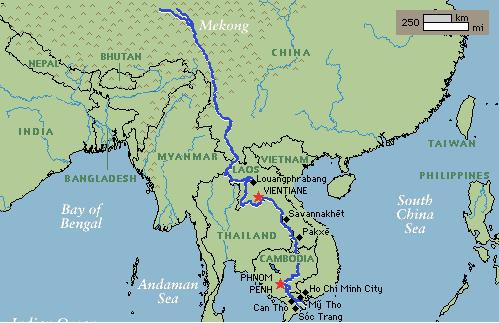
|
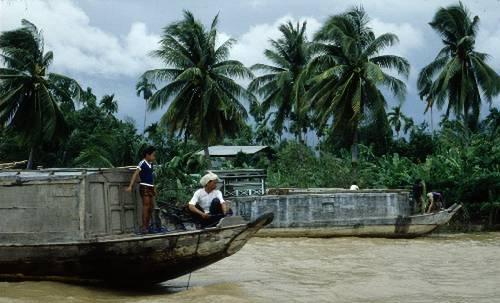
| Mekong River, Vietnam
The Mekong River is one of the principal rivers of Southeast Asia. In southern Vietnam, people use the river as an inexpensive transportation route. After passing through Vietnam, the Mekong enters the South China Sea. |
Mekong
(Tibetan Dza-chu; Chinese Lancang Jiang; Thai Mae Nam Khong), river in southeastern Asia, the longest river in the region. From its source in China's Qinghai Province near the border with Tibet, the Mekong flows generally southeast to the South China Sea, a distance of 4,200 km (2,610 mi). The Mekong crosses Yunnan Province, China, forms the border between Myanmar (formerly known as Burma) and Laos and most of the border between Laos and Thailand, and flows across Cambodia and southern Vietnam, emptying into the South China Sea. In the upper course are steep descents and swift rapids, but the river is navigable south of Louangphrabang, Laos. French explorer Michel Peissel discovered the source of the Mekong in 1994 at a high mountain pass.
The basin of the Mekong is an important agricultural area, with rice as the main crop. Without irrigation, rice cultivation is impossible during the long dry season. The United Nations (UN) started the Mekong River Development Project in 1957 to improve flood control, navigation and irrigation, and to develop hydroelectric power plants along the river. However, the project's progress was impeded by the Vietnam War (1959-1975) and political instability in Cambodia and other countries in the region. In the 1990s interest was renewed in developing the hydroelectric power potential of the Mekong River. Officials from four of the six nations that share the Mekong—Cambodia, Laos, Thailand, and Vietnam—met to make plans regarding this development; China and Myanmar did not attend the talks. By 1996, 54 dams were scheduled to be built on the Mekong. Manwan Dam in China's Yunnan Province was the first to be completed; it began producing power in 1993. Thailand completed Pak Mun Dam in 1994. Some of the nations involved have voiced concerns about the dam construction. The nations downriver worry that China's dam plans will interfere with the flow of the river, either flooding land downriver or changing the nature of the river so that hydroelectric projects downstream will lose some of their power potential. Additionally the two existing dams have had a negative effect on the environment, flooding certain areas and destroying fish habitats, which affects the fishing industry of native villagers.
Harvesting Pineapples on the Mekong
The fertile floodplains of the Mekong River support a variety of crops, and the river is important for agriculture in the countries that lie on its banks. Here, Vietnamese farmers gather pineapples from a field on the shores of the Mekong. | 
|
RIVERS AND LAKES
Cambodia’s most important river is the Mekong, the longest river in Southeast Asia and the tenth largest in the world. The Mekong flows from north to south through Cambodia and is navigable for much of its course. Other rivers in the country include the Tônlé Srêpôk and the Tônlé Sab.
PLANTS AND ANIMALS
Forests cover 53 percent of Cambodia’s land. The densest forests thrive in the mountains and along the southwestern coast. Higher plains and plateaus contain savannas covered with high, sharp grass. Plants growing in Cambodia include rubber, kapok (a tree with seeds that yield a cotton-like fiber), palm, coconut, and banana, all of which are exploited commercially.
Wildlife in Cambodia includes elephants, deer, wild ox, panthers, bears, and tigers. Cormorants, cranes, parrots, pheasants, and wild ducks are also found, and poisonous snakes are numerous. Logging and mining activities, along with unregulated hunting, have diminished the country’s wildlife rapidly.
ENVIRONMENTAL ISSUES AND POPULATION
Deforestation is the most serious threat to Cambodia’s environment. In the 1960s and 1970s Cambodian forests and wetlands were harmed by bombings and defoliants used in the Vietnam War. In the 1970s and 1980s the damage continued with the disastrous agricultural policies of the Khmer Rouge regime and civil war. In the relatively peaceful 1990s, timber became an important export for Cambodia. More than 800,000 hectares (2 million acres) of Cambodian forest were cut down from 1990 to 1995. In 1995 the government responded by banning log exports, but illegal timber exporting has led to continued deforestation. The annual rate of deforestation in 1990-2000 was 0.58 percent.
Many of the mangrove swamps crucial to the country’s fisheries and wildlife have been destroyed. The loss of wildlife habitat and the negative environmental effects of logging and mining industries have caused a decline in biodiversity. In 2000, 86 species were listed as threatened in Cambodia, including 21 species of mammals. In addition, the pollution and contamination of streams and lakes has made much of the country’s fresh water unsafe. Only 30 percent (1999) of all Cambodian people have access to safe, drinkable water, and only 18 percent (1999) have access to sanitation.
In addition to banning the export of lumber, the Cambodian government has declared a large portion— 16.2 percent (1997)—of the country’s total land area protected. The government has also ratified international environmental agreements pertaining to climate change, desertification, endangered species, marine life conservation, ship pollution, and tropical timber.
Climate
Cambodia has a tropical monsoon climate. December and January are the coolest months, while March and April are the hottest. The country’s rainy season extends from May to October. Average annual rainfall is about 1,400 mm (about 55 in) on the central plain and increases to as much as 3,800 mm (150 in) in the mountains and along the coast. The average annual temperature is about 27°C (about 80°F).
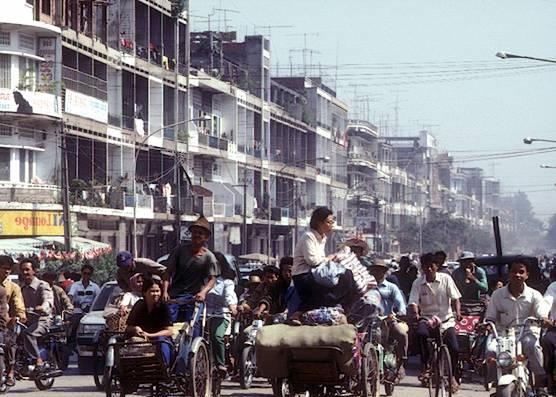 | Bustling Capital
Bicycles, scooters, and rickshaws crowd the streets in Cambodia’s capital, Phnom Penh. |
The rate of infant mortality is also high. The population density is 69 persons per sq km (179 per sq mi), with the densest concentrations on the heavily cultivated central plain. The mountainous regions of the country, where malaria is widespread, are thinly populated, as are the poorly watered northern provinces. During the late 1970s, under the brutal rule of the Khmer Rouge, all of Cambodia’s towns were depopulated, and residents were forcibly relocated to rural areas. A process of reurbanization began in the 1980s.
Cambodia’s capital, Phnom Penh, is situated at the junction of the Mekong and Tônlé Sab rivers. Other major cities are Bãtdâmbâng, Kâmpóng Cham, Kâmpôt, and Cambodia’s only deep-water port, Kâmpóng Saôm, located on the Gulf of Thailand.
ETHNIC GROUPS, LANGUAGES AND RELIGION
Ethnic Cambodians, or Khmer, constitute 90 percent of the population. About 5 percent of the country’s inhabitants are of Vietnamese origin, and 1 percent are Chinese. Seminomadic tribal groups concentrated in the mountainous northeast make up the remaining 4 percent of the population.
Cambodia’s official language is Khmer, or Cambodian, which belongs to the Mon-Khmer family of languages (see Austro-Asiatic Languages). French was formerly an important secondary language in the country, but English gained considerable ground in the 1990s. Other languages spoken include Vietnamese and an assortment of South Chinese dialects.
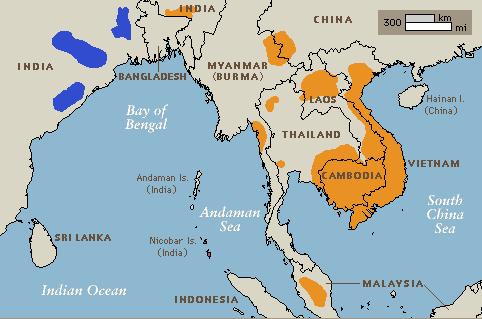 | Austro-Asiatic Languages
The Austro-Asiatic languages, spoken in Southeast Asia, consist of three language groups: Mon-Khmer, Nicobarese, and Munda. The most widely spoken languages in this family are Khmer, Mon, and Vietnamese. Some of the Austro-Asiatic languages, especially Vietnamese and the Munda group, show a marked influence from the neighboring Indian and Chinese languages. This map shows where each subfamily is spoken. |
Austro-Asiatic
important language family having three subfamilies: Munda, spoken by several million people in eastern India; Nicobarese, with a few thousand speakers in the Nicobar Islands; and Mon-Khmer, divided into 12 branches with almost 100 languages spoken by some 35 to 45 million people in Southeast Asia. Among Mon-Khmer languages are Khmer, the national language of Cambodia; Mon, a closely related language spoken in parts of Myanmar (formerly known as Burma) and Thailand; and Vietnamese.
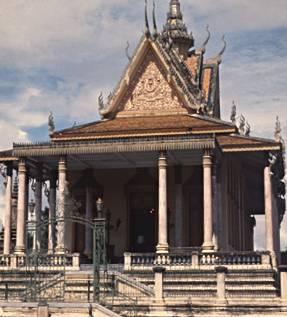 | Cambodian Pagoda
Some 95 percent of Cambodia’s population adheres to Theravada (Hinayana) Buddhism. Buddhists built many pagodas throughout the country to serve their religious needs. Pagodas can take a number of shapes, depending on the country of influence, but all are used as shrines, memorials, or tombs. |
More than 90 percent of Cambodia’s inhabitants adhere to Theravada Buddhism, which is the dominant religion in most Southeast Asian nations. Buddhism originated in India in the 6th century bc and arrived in Cambodia during the first centuries ad. At first Mahayana Buddhism predominated, but after the 14th century Theravada gradually replaced the older school as the primary religion. Nevertheless, a minority of modern Cambodians still practices Mahayana Buddhism. Other religions practiced in Cambodia include Roman Catholicism and Islam.
ARTS AND CULTURE
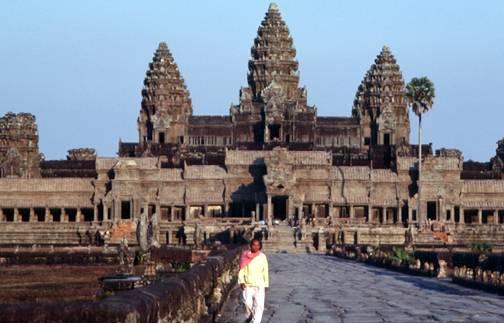 | Angkor Wat, Cambodia
This 12th-century stone structure in central Cambodia is part of Angkor Wat, the largest temple complex in the world. Angkor Wat covers an area of about 80 hectares (about 200 acres) and has a moat with a circumference of almost 4 km (almost 2.5 mi). Angkor Wat was built by King Suryavarman II as a Hindu temple dedicated to the god Vishnu. |
Throughout Cambodia’s history, religious principles guided and inspired its arts. A unique Khmer style emerged from the combination of indigenous animistic beliefs and the originally Indian religions of Hinduism and Buddhism. These two religions, along with the Sanskrit language and other elements of Indian civilization, arrived in mainland Southeast Asia during the first few centuries ad. Seafaring merchants following the coast from India to China brought them to the port cities along the Gulf of Thailand, which were then controlled by the state of Funan in Cambodia. At varying times, Cambodian culture also absorbed Javanese, Chinese, and Thai influences.
Between the 9th and 15th centuries, a prosperous and powerful empire flourished in northwestern Cambodia. The Khmer kingdom of Angkor, named for its capital city, dominated much of what is now Laos, Vietnam, and Thailand. The kingdom drew its religious and political inspiration from India. The literary language of the court was Sanskrit; the spoken language was Khmer. Massive temples from this period, including Angkor Wat and the Bayon at Angkor Thum, testify to the power of Angkor and the grandeur of its architecture and decorative art. The unparalleled achievements in art, architecture, music, and dance during this period served as models for later cultural development in Cambodia.
Angkor faded into obscurity after the capital moved south to Phnom Penh in the 15th century, probably due in part to frequent invasions by the neighboring Thais. The jungle rapidly grew over the monuments. In the centuries that followed, frequent wars reduced the territory, wealth, and power of Cambodian monarchs. However, an independent state with its capital near Phnom Penh survived until the 19th century. The most important work of Cambodian literature, the Reamker (a Khmer-language version of the Indian myth of the Ramayana), was composed during this time.
France, which began administering Cambodia in 1863, rediscovered the temples at Angkor and worked to preserve them beginning in the early 20th century. Cambodia’s traditional culture and the monuments of Angkor were endangered between 1970 and 1990 due to civil war. The Communist Khmer Rouge regime, which opposed and mistrusted religion and education, banned all of Cambodia’s traditional arts and its written language. Since 1991, when Cambodia’s warring factions signed a peace accord, international organizations have helped the Cambodian government restore the sites at Angkor and revive Cambodia’s traditional crafts.
EDUCATION AND LITERATURE
An estimated 35 percent of Cambodia’s adult population is literate. Public education is free and compulsory for the first 6 years. Primary school attendance increased rapidly in the 1990s, and by 1997 virtually all children were enrolled, as well as many older people who were unable to attend school in earlier years. Secondary education was more limited, with only 24 percent of eligible children enrolled. Seven institutions of higher learning, including the University of Phnom Penh, the University of Fine Arts, and the University of Agricultural Sciences, operate in the country. Only 1 percent of Cambodians of usual university age were enrolled in these schools in 1997.
Perennially handicapped by insufficient funding, Cambodia’s educational system was devastated in the late 1970s when the Khmer Rouge regime closed schools and executed thousands of teachers. The regime viewed intellectuals, among others, as potential sources of opposition to its attempt to create an ideal socialist, agrarian society. In the 1980s thousands more teachers fled the country or sought better-paying work. Ever since then, efforts to revive the education system have been hampered by a shortage of funds and trained personnel.
These popular legends are based on the great epics of ancient India, the Mahabharata and the Ramayana, and on the Jataka tales, stories about the previous lives of the Buddha. Episodes from the Reamker have been portrayed throughout history in all Cambodian arts, from scenes carved in stone at Angkor to mural paintings on the enclosure wall of the Royal Palace at Phnom Penh. Cambodia’s earliest written documents are stone slabs inscribed in Sanskrit (dating from the 6th century) and Khmer (dating from the early 7th century), which provide a genealogy of Khmer kings and their endowments to the temples.
"Myths and legends passed down orally through the generations form the heart of Cambodian literature."
The first Cambodian novel, Suphat, by Rim Kin, was published in 1938 after the French introduced printing techniques to Cambodia. During the Khmer Rouge regime, literature was restricted to poems, written on themes of peasant and agricultural development, and revolutionary songs. Most Cambodian literary works published during the late 20th century were written by Cambodian refugees living abroad, mainly in France and Thailand.
Jataka
(Sanskrit for “Birth”), any of the edifying stories of the previous lives of the founder of Buddhism, Buddha. Because Buddhism accepts the doctrine of rebirth (see Transmigration), it is assumed that the Buddha progressed toward his enlightenment through many preceding existences. According to early Buddhist doctrine, as part of his final enlightenment, the Buddha gained knowledge of all his former lives. Jatakas, frequently originating from the Buddha himself, tell the stories of these lives, presenting the Buddha in various existences—for example, as a prince, a god, and even a deer. Five hundred forty-seven such stories are contained in the early canon of Buddhism known as the Tipitaka, and illustrations of the stories are found as sculptures in Buddhist temples. The Jatakas also relate the meeting of another Buddhist figure, the so-called future Buddha, then called Sumedha, with the first of the 24 Buddhas before him, Dipankara, who foretells Sumedha's eventual enlightenment. In another famous tale, the Buddha comes upon a hungry tigress and her starving cubs and sacrifices himself to feed them. Despite inconsistencies such as the immense lapse of time that was supposed to separate such events from the Buddha's own day, all Jatakas reflect life in early India. Most serve as parables for Buddhist readers, using the Buddha's past lives to instruct the laity, or those outside the Sangha (monastic community), about moral virtue and the law of karma (habit or action).
MUSIC, DANCE, THEATER AND MUSEUMS
Khmer classical dance derived from Indian court dance, which traces its origins to the apsarases of Hindu mythology, heavenly female nymphs who were born to dance for the gods. The traditions of Thailand and Java (in Indonesia) also influenced the music and dance of Cambodia. In classical Cambodian dance, women, dressed in brightly colored costumes with elaborate headdresses, perform slow, graceful movements accompanied by a percussive ensemble known as the pinpeat. Pinpeat orchestras include drums, gongs, and bamboo xylophones. In Cambodia’s villages, plays performed by actors wearing masks are popular. Shadow plays, performed using black leather puppets that enact scenes from the Reamker, are also enjoyed. Folk dancing is popular in rural Cambodia and is performed spontaneously to a drumbeat.
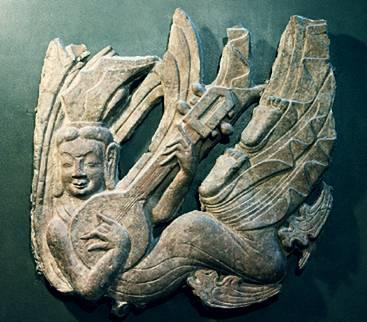 | Apsaras as a Musician
In Hindu mythology apsarases were celestial nymphs who often appeared as musicians or dancers. This early 6th-century Chinese relief carving, originally found on a tomb, is at the Victoria and Albert Museum, London, England.
|
Apsaras
(Sanskrit, moving in the water), in Hindu mythology, heavenly nymph of great beauty, often represented as a dancer at the court of the Hindu god Indra in svarga, his heavenly kingdom. In early Hindu sculptures apsarases are frequently depicted with Indra's musicians, the gandharvas, their heavenly consorts. Apsarases also appear in Buddhist art, such as the frescoes at the Ajanta caves, located in central India.
The apsarases appear to have been originally water nymphs associated with rivers and seas, and who had superhuman powers and could change form at will. According to the Sanskrit histories of gods and primordial times—the Puranas—Apsarases arose from the sea of milk when it was churned in the dawn of mythical time to produce the magical food amrit for the deities called Devas. In certain mythological stories, Indra sends an Apsaras to earth to distract sages practicing austerities. For instance, in the story of Shakuntala, made famous by a classical Sanskrit play of the 5th-century Indian dramatist Kalidasa, Shakuntala's mother, the apsaras Menaka, is sent from heaven to distract and seduce Visvamitra, a sage who is gaining alarming levels of yogic power through his concentrated meditation. The most famous apsaras is Urvasi, who falls in love with the mortal Pururuvas, and vows to stay with him providing she never sees him naked. They live happily for a while, but the gandharvas, jealous of Urvasi's relationship with a mortal, contrive to trick Pururuvas into rushing out one night to rescue Urvasi's pet lamb, and send a flash of lightning to illuminate his nakedness. Urvasi disappears and Pururuvas is left in despair, until he is finally shown how he can transform himself into a gandharva and is thus reunited with Urvasi in svarga. An Apsaras would also serve as a reward to heroes fallen in combat, rushing to the battle site and carrying them into heaven.
The changing perception and role of apsarases, from immortal women with remarkable sexual freedom to seductresses sent by Indra to distract holy men from their meditation, has been the subject of much analysis. In some areas of India, apsarases were worshiped as part of mother-goddess cults, and an association between apsarases and hierodules (temple prostitutes) is apparent in the early stories of Hindu mythology.
The Cambodian pinpeat ensemble is traditionally heard on feast days in the pagodas. It is also a court ensemble used to accompany classical dance for ritual occasions or theatrical events. The pinpeat is primarily made up of percussion instruments: the roneat ek (high bamboo xylophone), roneat thung (low bamboo xylophone), kong vong touch and kong vong thom (small and large sets of tuned gongs), sampho (two-sided drum), skor thom (two large drums), and sralai (quadruple-reed instrument).
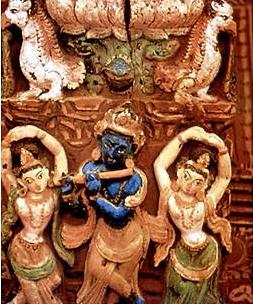 | Gandharva
In Hindu mythology gandharvas are musicians who accompany the beautiful nymphs, the Apsaras. Together they appear as divine couples on the sculptured facades of many ancient Hindu temples.The gandharva here is blue, center. |
Gandharva
(Pali, Gandhabba), in Hindu mythology, celestial musician who serves the Hindu god in his heavenly kingdom of svarga. The music of the gandharvas accompanies the dancing of the apsarases, beautiful nymphs who entertain in Indra's court. Gandharvas and apsarases appear as divine couples decorating the sculptured facades of many ancient Hindu temples. In early Hindu texts, such as the Upanishads, gandharvas appear as shape-shifting spirits able to possess mortal women. They also appear in Buddhist literature as semidivine entities, existing in a transient state between death and rebirth. Gandharvas traditionally number 6333 and haunt the mountains, forests, and air of India. They often enter into battle with human warriors, imparting great wisdom upon those strong enough to overcome them. Gandharvas are considered so attractive that in India, love at first sight is known as a Gandharva marriage. Gandharvas guard the elixir of the gods, soma, which promises eternal life
The Khmer Rouge closed cultural institutions during their rule, but many were reopened in the 1980s. The National Museum of Cambodia in Phnom Penh is Cambodia’s largest museum, with objects dating from prehistory to the 18th century. The museum houses the largest collection of Khmer art in the world and is renowned for its Angkor-era bronze and stone images. The museum’s exhibits also include ceramics, wooden ornaments, musical instruments, weaving looms, lacquer, and silver. The University of Fine Arts in Phnom Penh is responsible for preserving Khmer culture. It has reopened with departments in music, dance, painting, architecture, and the plastic arts.
The Tuol Sleng Museum (Museum of Genocide), also in Phnom Penh, is a former high school that was used by the Khmer Rouge as a killing center and since then has been converted into a museum. Displays focus on the atrocities of the Khmer Rouge and include torture instruments and photographs of those killed.









